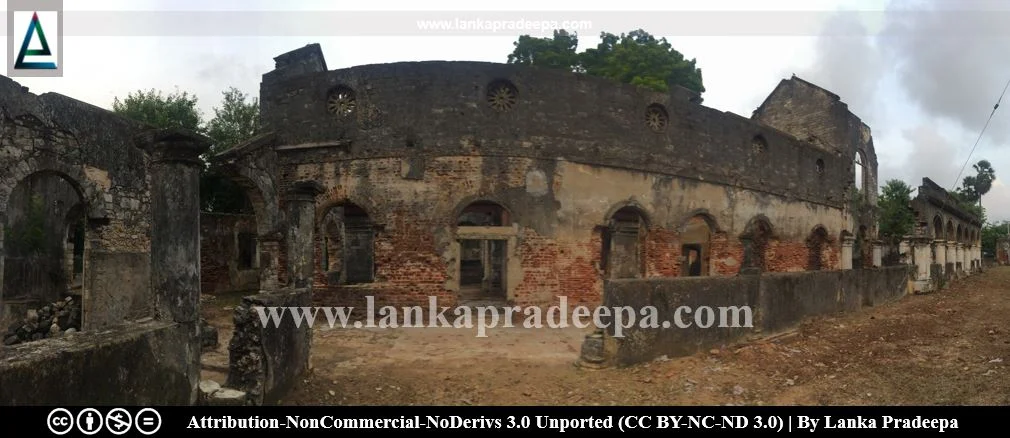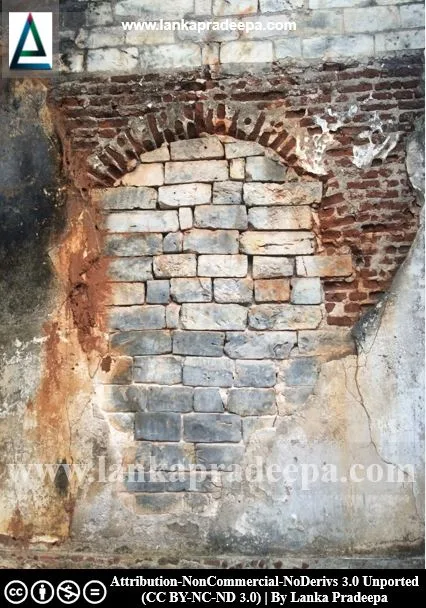
The old Jaffna Kachcheri Building (Sinhala: යාපනය පැරණි උද්යාන කච්චේරිය; Tamil: பழைய பூங்கா, யாழ்ப்பாணம்) is located in Jaffna Old Park premises near the Secretariat of the Governor of Northern Province in Jaffna District, Sri Lanka. The word Kachcheri (or District Secretariat) is used to denote the principal government department that administrates a district in Sri Lanka.
History
Although the history of this site runs back to the period of Dutch rule (1658-1796 A.D.), the existing building at the site has been built during the British period, around the time of P. Dyke, a British regional commissioner who purchased the adjacent land that is Old Park today and built a residence and garden in 1829 (Haramoto et al., 2015).
Historical accounts regarding this building can be found in several written sources such as Volume II of the History of the Public Works Department from 1796-1896 (Dias et al., 2016; Wijebandara, 2014). During this period, the building had been used as Kachcheri or the principal administrative centre of the Jaffna District (Dias et al., 2016).
The description found in Martyn's Notes on Jaffna (1923) reveals that by 1844, there was a Kachcheri building in Jaffna;
1844-June. No less than 150 elephants reported to have been killed in Wanni, Government having offered a reward of fifteen shillings for every elephant destroyed. A certain number was also reported to have been killed in the Mannar and Pachchillapally districts. The tails of the elephants as proof of the animals having been killed were sent to the Jaffna Kachcheri, where they were cut in pieces and buried.
Citation: Martyn, 1923. p.22.
Building
The Jaffna Kachcheri building is considered an important monument that exampling the colonial architecture of the country (Dias et al., 2016; Wijebandara, 2014). Remaining architectural elements such as massive thick walls, Roman arches, inner courtyards, and shaped windows and doors majorly show the 19th century British architectural standards (Dias et al., 2016; Wijebandara, 2014). Architecturally, it features both a neo-Renaissance style as represented by semi-circular arches, cylindrical colonnades and verandas with a balustrade above the overhang of the front entrance, and the neo-Gothic style of using rose windows (Haramoto et al., 2015).
The building is oval in shape when excluding the projection at the entrance and surrounds a large garden in the centre (Haramoto et al., 2015). The brick and limestone-built walls of the building are considerably thick and had been plastered with coral to give a smooth appearance (Wijebandara, 2014). In some places, the floor has been decorated with mosaic ceramic pieces from the Dutch and subsequent British periods. The building also has a few inner courtyards and the largest of them is surrounded by a complex building system in a circular formation (Dias et al., 2016; Wijebandara, 2014).
A protected monument
The old Kachcheri building belonging to the area known as the Old Park (Parani Udhyanaya) situated in No. J/76 Jaffna Grama Niladhari Division in the Jaffna Divisional Secretary’s Division is an archaeological protected monument, declared by a government Gazette notification published on 30 December 2011.





.
See also
References
1) Dias, M.; Koralage, S.B.; Asanga, K., 2016. The archaeological heritage of Jaffna peninsula. Department of Archaeology. Colombo. pp.206-207.
2) Haramoto, T.; Inouchi, C.; Koizumi, Y.; Fukuyama, Y., 2015. Survey Report on the Protection and Utilisation of Cultural Property in the Northern and Northeastern Provinces of Sri Lanka. Japan Consortium for International Cooperation in Cultural Heritage. pp.25-28.
2) Haramoto, T.; Inouchi, C.; Koizumi, Y.; Fukuyama, Y., 2015. Survey Report on the Protection and Utilisation of Cultural Property in the Northern and Northeastern Provinces of Sri Lanka. Japan Consortium for International Cooperation in Cultural Heritage. pp.25-28.
3) Martyn, J. H., 1923. Martyn's Notes on Jaffna: Chronological, Historical, Biographical. American Ceylon Mission Press. Tellippalai. Ceylon. p.22.
4) The Gazette of the Democratic Socialist Republic of Sri Lanka. No: 1739. 30 December 2011. p.1090.
5) Wijebandara, I.D.M., 2014. Yapanaye Aithihasika Urumaya (In Sinhala). Published by the editor. ISBN-978-955-9159-95-7. pp.103-109.
5) Wijebandara, I.D.M., 2014. Yapanaye Aithihasika Urumaya (In Sinhala). Published by the editor. ISBN-978-955-9159-95-7. pp.103-109.
Location Map
This page was last updated on 16 May 2023


